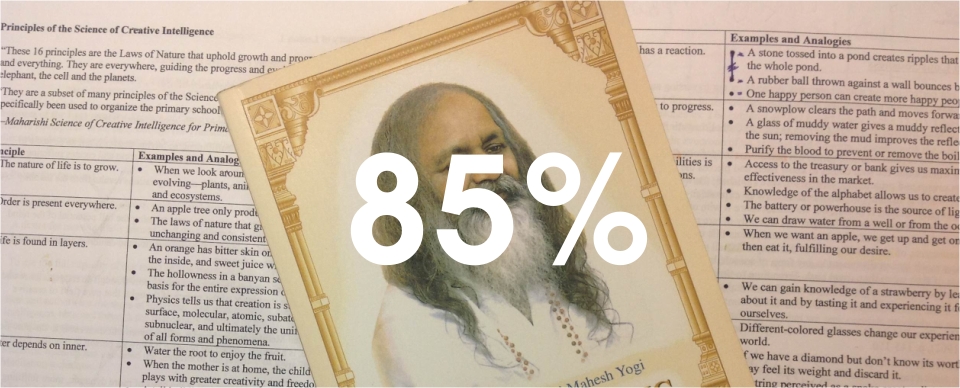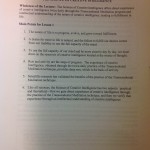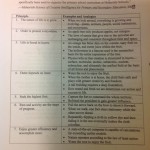As I referenced in my entry : The 90 min Homework Myth, an example of a Science and Technology of Consciousness (STC) homework assignment which harbors more ambiguity in premise than content — at the student’s expense.
The day’s lesson covered “The 16 SCI Principles.” SCI, Science of Creative Intelligence, is one of the fundamental paradigms of perspective at the core of both Maharishi University of Management and Maharishi School for the Age of Enlightenment. Oprah Winfrey highlights SCI in her “Exclusive Webisode: 16 Principles of the Science of Creative Intelligence”. I briefly iterate below, including attached photos of worksheets guiding students through the lesson.
1. The nature of life is to grow.
2. Order is present everywhere.
3. Life is found in layers.
4. Outer depends on inner.
5. Seek the highest first.
6. Rest and activity are the steps of progress.
7. Enjoy greater efficiency and accomplish more.
8. Every action has a reaction.
9. Purification leads to progress.
10. The field of all possibilities is the source of all solutions.
11. Thought leads to action, action leads to achievement, and achievement leads to fulfillment.
12. Knowledge is gained from inside and outside.
13. Knowledge is structured in consciousness.
14. Harmony exists in diversity.
15. The whole is contained in every part.
16. The whole is greater than the sum of the parts.
The homework assignment was :
Explain to your curious 10-year-old niece 3-5 SCI principles that correspond to your main points from Monday’s homework.
First explain each principle and then use an example she would understand. (Write 300-400 words)
Approaching these assignments is more a skill in assessment, the loose terms giving rise to ambiguity. The request, rooted in the simulation of a ten(10) year old family member curious of SCI Principles, requires the rendering of instructional language to convey the concepts — three to five in number — in a manner which “my” ten(10) year old relative might grasp the corpus of it’s constitution. It also includes rendering of additional language to convey the students’ proficiency with each SCI Principle addressed.
My homework submission as follows:
1. The nature of life is to grow.
The nature of growth is to change, for change to exist we must realize a difference. Change is not indicative of growth inherently, growth is the result of favorable change. Favorable change, within the scope of life, is any change that brings greater support to the laws and forces which maintain the universal existence of life.
For example, A sunflower changes its posture to follow the sun across the sky. From the sunlight’s initiation of the day, to its resolution at night, it brings the greatest possible support to the laws and forces which maintain its existence; Optimization of photosynthesis.
4. Outer depends on inner.
That which is dependent is considered to exist on the “outside” of the relationship between itself and that on which it is dependent.
For example, the caboose of a locomotive is set in motion through it’s connection with the preceding car, and so on, until the inner most layer of the locomotive is discovered as the source of motion on which all successive cars are dependent; The caboose is inherently dependent on the locomotive’s engine for motion, and all successive cars which bind it to the engine.
5. Seek the highest first.
Seek that which embodies the ultimate authority of any given system, that the nature of it’s constitution will reveal the scope and scale of the underlying potential.
For example, with any game we play, there exist rules which regulate and govern it’s play. The greater the understanding of these rules, the greater ones understanding of the game, and the more effective the actions which comprise ones play as they leverage knowledge of the game to develop strategy.
6. Rest and activity are the steps of progress.
Progress is essentially a toggle between activity, and a lack thereof. Progress is an operation of change. Change is dependent on the realization of a difference created by activity, that each period of activity is followed by realization of the resulting difference; interpolation.
For example, counting my steps as I walk across the room, each step’s execution (action) is initiated the moment one foot leaves the floor, and resolves when that foot returns to the floor some distance beyond the location which it left. In the process of traversing the room, progress (change) is quantified at the resolution of each step.
14. Harmony exists in diversity.
The principal of harmony requires two or more differing subjects, whereas the relationship between the subjects is comprised of a quality that doesn’t exist in the subjects individually.
In this way, harmony is a state of agreement between differing subjects which posses diverse values within a common scope. This is not to be confused with the state of congruence, where as differing subjects posses non-diverse (common) values within a common scope.
For example, both Sodium and Chlorine are poisonous in the context of human consumption, however, these two poisons bond ionically to form a commonly consumed condiment known as table salt; Table salt is the harmony between the elemental diversity of Sodium and Chlorine relative to human consumption.
I had initially approached seven or eight of the required three to five principles, and chose what I felt were the best results for the assignment. There was a process of composing and editing invested in response to an already lengthy consideration of the homework’s premise.
Unfortunately, as in so many other cases, the professor’s response to my homework was an unsavory surprise.
You’ve given some great examples here to illustrate your SCI principles, Xxxxxx, and I appreciate the way you’ve elaborated on each principle to give a more complete picture of its significance. At the same time, you present these ideas here in a more formal, professional language, whereas the assignment is to explain these principles to your ten-year-old niece–something that would require much simpler expressions. Most ten-year-olds might not understand much of what you’re saying here, simply because they don’t have such an extensive vocabulary yet. It can be fun to try rewriting these with a more basic vocabulary: for example, in your walking analogy, something like “When you walk across the room, one foot leaves the floor and comes down, and then the other foot leaves the floor and comes down. So one foot is moving and the other is staying still. That’s why rest and activity are the steps of progress.” You get the idea…
The professor felt I hadn’t simplified my descriptions enough to entertain the mental capacity of a ten(10) year old. The course, STC108, never addressed these avenues of cognitive development, yet an aspect hardly central to the premise lays sway to my grade in the order of a 15% variance.
Moreover, the professor’s revision of my example seemed to lack the core of the concept: Change, in this example, isn’t that “one foot is moving and the other is staying still” as the professor described, rather, it’s the resulting difference created between two states (rest and activity) as I had appropriately described. Even further, they explicitly cite vocabulary as the reason my descriptions would escape a 10-year-old’s (4th Grade) cognition. With all due respect to the professor’s Ivy League degree, I propose the 10-year-old builds vocabulary often times from the “context” in which unfamiliar words are leveraged. This phenomenon is commonly referred to as “Words in Context” or “Context Clues.” You get the idea…
While STC108 doesn’t include instruction in the scope of cognitive development, I’ve addressed the topic in yet another MUM homework assignment in my composition of this tidy haiku.
Narrow glass holds more.
It’s taller, filled much higher,
wide glass filled lower.
In this haiku I express the corpus of the Constructionists’ concept of Centration within the Pre-operational Stage of cognitive development. A 10-year-old would fall into the Concrete Operational Stage, in which Piaget determined that children are able to incorporate inductive reasoning. Inductive reasoning involves drawing inferences from observations in order to make a generalization — such as “Words in Context” or “Context Clues.”
Because it’s this level of research in the field of cognitive development that I was willing to exert in the hours of consideration of the homework assignment, that my actions would result in correct responses to ambiguous requests, I would only expect the professor meet my performance with like consideration.
But that’s how easily 15% — or more — might be taken from some students. It didn’t matter how many times I had re-written my descriptions the night prior. How closely I illustrated the parity between the SCI principal and my example. It didn’t matter how many hours I invested developing the perfect solution to a riddle cloaked beneath the veil of homework. It didn’t matter how well I grasp the content of the days lesson. It didn’t matter if I had meditated or not. It didn’t matter if I were excited about education, or Maharishi Mahesh Yogi, or Transcendental Meditation.
As the 8th Principle of the Science of Creative Intelligence dictates, the separation between excellence and mediocrity at Maharishi University of Management rests firmly NOT in the intent and actions of the student, but rather, the reactions of the professors and the underlying administration; For every action there is a reaction.
What interest has Maharishi University of Management in requesting that it’s college level students posture homework assignments in terms of Elementary School comprehension? This is particularly suspect in consideration that Science and Technology of Consciousness is a core prerequisite to all other classes at the university, unlike a one-off Writing class where communication to a particular audience might be central to the premise.
Is the university suggesting that I teach this ideology of SCI Principles to my ten year old relatives? Perhaps the university is biasing the assignment in favor of students with a 10 year old vocabulary? Perhaps this is the MUM “Creative Intelligence” in grading homework; hedging GPA. Quite possibly, the school isn’t aware of it’s role as a university, the lesson handout’s lead quote cited from “Maharishi Science of Creative Intelligence for Primary and Secondary Education, 2006”
As my encounter with the assignment has demonstrated, assignments of this nature undermine the primary function of homework; they fail to reveal the students’ proficiency or mastery of the curriculum’s content. In this case, the assignment and the professor’s response reflect on my proficiency with the content of the lesson, while my grade suggests a merely average mastery of the lesson — on the basis of an ancillary objective in which the professor leveraged a flimsy — false — personal opinion to besmirch my effort and frustrate my education to an unjust degree.
Not that I believe my achievement of the homework’s objective was in fact worthy of 100%, as I could — with great rigor — critique my submission into the range of 60% – 70% — provisioning a matrix of concisely defined metrics and thresholds, order being present everywhere. For example, I might propose that sunflowers in fact DO NOT follow the sun accross the sky, an illusion rooted in their uniform alignment, the result of heliotropism in an earlier development stage.
But the wholeness of the matter raises one question: Why does Maharishi University of Management marginalize 4th Grade potential in the scope of vocabulary?
Such the position is hardly congruent with Science of Creative Intelligence principle 10 “The field of all possibilities is the source of all solutions.”
Familiarity with Sanskrit, surely MUM understands how an Etymology component can rapidly expand students’ potential vocabulary. But in this case, sadly, the professor is essentially expressing that it’s own Maharishi School for the Age of Enlightenment 4th graders lacked the ability to comprehend my language, that their vocabulary would be insufficient. More over, the professor believes so little in the youth that in fact they would wager demerit in the order of 15% on this principle alone; that my confidence in the potential of a 4th grade student’s vocabulary rendered me merely a satisfactory student rather than exceptional.
I brought the discrepancy in 10-year-old’s potential vocabulary to the professor’s attention, the retort “Homework only accounts for 30% of your final grade.” was concurrently commission a fallacy of relevance, an irrelevant appeal to course component weight. In this genius swoop of oratory the professor marginalizes the effort of the entire class.
The argument — unregulated gerrymandering of academic rubric in alignment with the professor’s erroneous assessment of a 10-year-old’s cognitive potential — is moot of course, modern day 10-year-olds fluently consuming vocabulary rich media in social networks, interactive gaming, the box office, and television — an encyclopedia, dictionary, and thesaurus just a tap away on a smart device.












